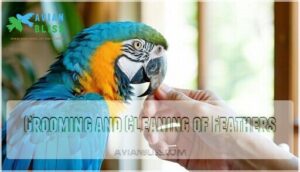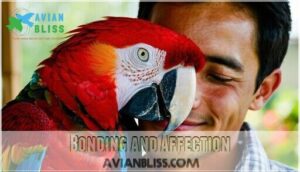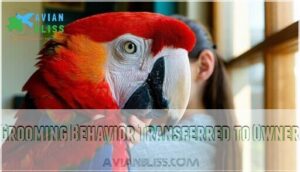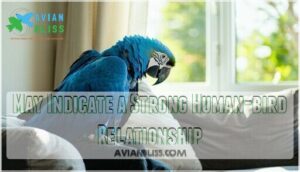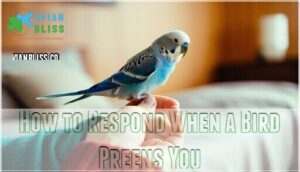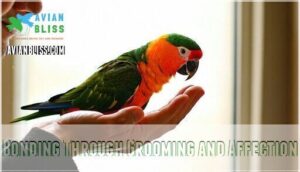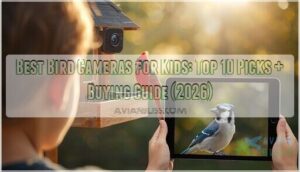This site is supported by our readers. We may earn a commission, at no cost to you, if you purchase through links.
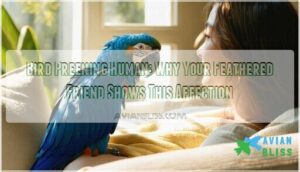
Birds naturally preen flock mates to strengthen social bonds, and your feathered friend sees you as part of their family.
This gentle nibbling at your hair, skin, or clothing mimics how they’d groom another bird’s feathers.
It’s their way of saying "I trust you completely."
Some birds focus on jewelry or buttons, treating these items like colorful feathers needing attention.
While endearing, this behavior shows your bird considers you their mate or closest companion.
Understanding why birds choose certain people for preening reveals fascinating insights about avian psychology and bonding patterns.
Table Of Contents
- Key Takeaways
- What is Preening Behavior in Birds?
- Why Do Birds Preen on Humans?
- How to Respond When a Bird Preens You
- Other Affectionate Behaviors Birds May Display
- Differences in Preening Behavior Between Birds
- Encouraging Healthy Preening Habits
- Bonding Through Grooming and Affection
- Frequently Asked Questions (FAQs)
- Why do birds preen?
- Do birds preen around you?
- Do pet birds preen humans?
- What does it mean if a bird preens?
- Do you need to preen a bird?
- How do birds preen each other?
- What does it mean when a bird preens on you?
- What does it mean if your bird cleans itself on you?
- What is preening behavior in humans?
- Why does my bird nibble on me?
- Conclusion
Key Takeaways
- Your bird’s preening behavior means they see you as family – they’re showing complete trust by treating you like a cherished flock member who deserves their care and attention.
- You can choose how to respond based on your comfort level – either embrace it as a bonding moment or gently redirect your bird to toys when the grooming feels overwhelming.
- Your bird’s preening style reveals their personality – some deliver gentle nibbles while others prefer more vigorous grooming sessions, and understanding these differences helps strengthen your relationship.
- You’ll recognize your bird’s comfort through their body language – relaxed posture and soft sounds mean they’re content, while raised feathers or backing away signals you should give them space.
What is Preening Behavior in Birds?
Preening is your bird’s natural grooming behavior where they use their beak to clean, align, and waterproof their feathers.
This essential activity maintains feather health, removes dirt and parasites, and distributes oils that keep their plumage in perfect condition for flight and insulation.
Grooming and Cleaning of Feathers
Your bird’s preening ritual involves thorough feather cleaning and maintenance using their beak.
This essential grooming behavior serves multiple purposes:
- Feather alignment keeps plumage properly positioned for ideal flight
- Preen oil distribution waterproofs feathers and maintains structure
- Parasite removal eliminates dirt, debris, and unwanted hitchhikers
Through careful beak cleaning motions, birds guarantee their feather care routine maintains insulation quality and overall feather health.
Owners can guarantee proper avian hygiene by purchasing specialized preening products.
Helps Maintain Feather Health and Insulation
Beyond simple grooming, your bird’s preening routine keeps them healthy and comfortable.
Oil Distribution spreads waterproof coating across feathers while Parasite Removal eliminates harmful bugs.
This feather maintenance supports proper Feather Alignment for flight readiness.
The process provides Sensory Stimulation too, reducing stress through self-care.
Birds use their beaks to perform feather barb alignment.
| Preening Function | Health Benefit | Your Bird’s Experience |
|---|---|---|
| Feather Waterproofing | Stays dry in rain | Comfort during baths |
| Oil Distribution | Prevents brittle feathers | Smooth, flexible plumage |
| Parasite Removal | Eliminates irritating pests | Relief from itching |
| Feather Alignment | Maintains flight ability | Confidence in movement |
| Sensory Stimulation | Reduces anxiety | Calming self-care ritual |
Often Done With The Beak
Most preening happens with precise beak movements that clean and align each feather. Your bird’s beak acts like a fine-tuned tool, carefully distributing oil from their oil gland across feathers. This beak usage prevents feather damage and maintains proper insulation.
- Beak function includes removing dirt, parasites, and debris from feathers
- Oil gland secretions get spread through methodical beak movements
- Preening injuries can occur if beaks become damaged or overgrown
- Beak health directly affects your bird’s ability to maintain their plumage
- Feather damage results when birds can’t properly use their beaks for grooming
Why Do Birds Preen on Humans?
When your bird starts preening you, they’re showing deep trust and affection by treating you like a fellow flock member.
Your bird treats you as family when they lovingly groom your hair and skin.
This grooming behavior means your feathered friend considers you part of their social group and wants to keep you clean and well-maintained, demonstrating affection.
Bonding and Affection
When your feathered friend preens you, they’re expressing profound trust and bonding.
This grooming behavior mimics natural flock interactions, showing they view you as family.
Trust indicators include ritualized gestures like head lowering, while mimicking flock dynamics creates equality expression.
Without proper social bonding, birds experience social deprivation.
Your bird’s preening demonstrates healthy human-bird bonding through affection.
Grooming Behavior Transferred to Owner
When your bird preens you, they’re mimicking flock behavior and transferring natural grooming behavior to their human companion.
This hygiene transfer shows equality expression – your feathered friend sees you as a flockmate deserving care.
Birds often engage in soliciting preening through head-lowering gestures.
Without this social interaction, bird preening human behavior helps prevent social deprivation and strengthens humanbird bonding through parrot human grooming.
May Indicate a Strong Human-bird Relationship
Why does this grooming behavior matter so much? When your bird preens you, it signals profound trust and bonding between you both.
This affectionate grooming demonstrates that your feathered companion views you as an equal member of its social hierarchy. The mimicking behavior transfers natural flock instincts to human-bird bonding, creating deep emotional connections. Birds may also show trust through relaxed feather positions.
Consider these meaningful moments:
- Your bird carefully preens your hair, showing complete trust in your presence
- You witness equality expression as your pet treats you like a cherished flockmate
- The gentle grooming behavior strengthens your bond through shared affection
This intimate act represents the pinnacle of avian trust and bonding.
How to Respond When a Bird Preens You
When your bird starts preening you, you’re experiencing one of the most intimate bonding behaviors in the avian world.
Your response depends on whether you welcome this gentle grooming or find it uncomfortable – you can either accept it as a sign of deep affection or gently redirect your feathered friend’s attention to a toy or perch.
Gently Discourage The Behavior if Unwanted
Sometimes your bird’s preening feels overwhelming or uncomfortable.
Redirect preening behavior by offering toys or treats when they start grooming you. Use positive reinforcement to reward appropriate interactions instead.
Ignore unwanted preening attempts rather than scolding your bird. Gradual desensitization helps—gently move away when preening begins.
Avoid punishment, which damages your bird human relationship and creates stress. Consider bird toy redirection to manage this behavior, using bird toy and redirection techniques for a better approach to handle unwanted preening.
Accept It as a Sign of Affection if Comfortable
When your bird chooses to preen you, reading cues becomes your best friend. If you’re comfortable with their gentle nibbling, embrace this parrot human affection wholeheartedly. This bird preening behavior signals deep parrot human trust and strengthens your parrot human bond.
Boundaries matter, so monitor your comfort levels during these intimate moments. Consider these preening etiquette guidelines:
- Allow gentle head and hair grooming sessions
- Offer positive reinforcement through soft praise
- Respect their natural human-bird interaction preferences
Each bird’s preening style differs. Some deliver quick, efficient sessions while others prefer extended grooming rituals. Pay attention to their body language and adjust accordingly. This mutual respect enhances your connection and demonstrates healthy parrot human affection.
By following these guidelines and being mindful of your bird’s behavior, you can foster a stronger, more loving relationship with your pet, built on mutual respect and trust.
Other Affectionate Behaviors Birds May Display
While preening shows your bird’s affection, it’s just one of many ways your feathered companion expresses love and trust.
Birds display their bond through cuddling, shoulder perching, and playful interactions that mirror their natural social behaviors.
Cuddling or Snuggling
Your bird’s cuddling or snuggling shows deep trust and affection.
When they tuck into your hair or nestle against you, they’re seeking comfort and demonstrating strong bonding rituals. This affectionate contact mirrors their natural flock behavior.
Monitor their comfort levels during parrot snuggling sessions, as excessive contact might cause overstimulation risks.
Safe snuggling means respecting their boundaries while enjoying these precious moments of human-bird interaction that strengthen your bond.
Sitting on Your Shoulder or Head
When your bird chooses your shoulder or head as their favorite perch, they’re showing trust and claiming you as their flock.
Your feathered friend sees you as their chosen flock member.
This behavior creates unique challenges that require careful balance between accepting affection and maintaining safety.
- Balance challenges – Your bird may struggle to stay steady on uneven surfaces
- Safety concerns – Sharp claws near your face and neck pose risks
- Dominance behavior – Height advantage can encourage territorial attitudes
- Training alternatives – Redirect to designated perches for healthier boundaries
Playing and Engaging in Games
Beyond perching, your bird craves interactive play that strengthens your bond.
Interactive toys and foraging games challenge their intelligence while mimicking natural behaviors. Training games teach new tricks, while puzzle toys provide mental enrichment.
Try mimicry games where you repeat sounds back and forth. These activities enhance bird behavior understanding, promote healthy bird interaction, and create meaningful bird bonding experiences through structured bird training and enrichment.
Differences in Preening Behavior Between Birds
Not every bird shows the same level of preening behavior toward their human companions.
Your feathered friend’s personality, species traits, and individual comfort level will determine how much they want to groom you.
Some Birds May Preen More Than Others
Just like people, your feathered friends show Individual Variation in their bird preening habits.
Species Differences play a major role – parrots and cockatoos naturally engage in more bird preening behavior than solitary species like hawks.
Age Factors matter too, as younger birds often preen less efficiently.
Captivity Effects can increase preening frequency compared to wild birds, while Environmental Stressors may trigger over-preening in some individuals.
Personality and Individual Preferences Vary
Individual parrot personalities create vast differences in bird preening behaviors. Preening intensity ranges from gentle nibbles to more assertive grooming sessions. Your parrot’s unique temperament shapes their parrot personality and determines how they express affection through the bird human relationship.
- Gentle vs. Rough: Some birds prefer soft, careful preening while others use firmer pressure during grooming sessions
- Location preference: Individual birds may focus on specific areas like hair, hands, or clothing during parrot human interactions
- Preening duration: Sessions can last seconds or extend for several minutes depending on your bird’s mood and energy
- Specific human: Many parrots choose one preferred person for bird preening activities, showing selective bonding behaviors
Observe Your Bird’s Cues to Understand Their Comfort Level
You’ll recognize bird comfort through their body language and vocalizations.
Relaxed birds approach willingly, while stressed ones show avoidance signals like backing away or raised feathers.
Trust indicators include gentle preening motions versus aggressive pecking.
Monitor preening intensity to gauge your bird’s comfort level with human interaction.
| Bird Cues | Comfortable Signs | Uncomfortable Signs |
|---|---|---|
| Body Language | Relaxed posture, approaching willingly | Backing away, raised feathers |
| Preening Intensity | Gentle, methodical movements | Rough, aggressive pecking |
| Vocalizations | Soft chirps, content sounds | Distress calls, silence |
| Eye Contact | Direct, calm gaze | Rapid blinking, looking away |
| Physical Response | Staying close, leaning in | Fluffing up, moving away |
Understanding parrot human comfort helps strengthen your bond while respecting your bird’s preening comfort boundaries.
Encouraging Healthy Preening Habits
Creating a supportive environment helps your bird maintain proper feather care naturally.
Your feathered companion needs specific tools and conditions to keep their plumage healthy.
Monitor behavior closely to catch any concerning changes early.
Essential elements for healthy parrot preening techniques include:
- Textured perches that naturally shape beaks and encourage normal parrot human routine interactions
- Bathing access through shallow dishes or gentle misting for effective parrot feather maintenance
- Balanced diet rich in vitamins A and E to support strong, vibrant parrot human feathers
Redirect over-preening with engaging toys or environmental changes if you notice excessive grooming.
Each bird develops unique parrot human groom preferences, so observe what works best for your companion.
Provide variety in perching surfaces and preening opportunities.
If bald patches or irritated skin appear, consult an avian veterinarian promptly.
Supporting natural grooming instincts promotes both physical health and mental well-being in your feathered friend.
Regular bathing options can encourage natural grooming behaviors.
Bonding Through Grooming and Affection
Grooming behaviors create powerful connections between you and your bird.
When your feathered friend preens you, they’re mimicking flock behavior and showing they view you as an equal partner.
This ritualized gesture demonstrates deep trust and affection in your human-bird bond.
Your bird’s preening communicates different messages through varying intensities.
Light nibbling shows contentment, while vigorous grooming might indicate they’re establishing social hierarchy.
Birds experiencing social deprivation often seek these interactions more frequently, making preening sessions essential for their wellbeing.
A bird’s comfort is shown through relaxed feather positions, which can be observed during preening.
Respond to your bird’s grooming attempts with gentle head scratches or neck rubs.
This reciprocal human-bird interaction strengthens your relationship and satisfies their natural social needs.
The following table outlines different preening styles and the messages they convey:
| Preening Style | Message | Your Response |
|---|---|---|
| Gentle nibbling | Pure affection | Enjoy the bonding moment |
| Focused grooming | Trust and preening ritual | Offer gentle head scratches |
| Quick, scattered preening | Seeking reassurance | Provide calm, steady presence |
Frequently Asked Questions (FAQs)
Why do birds preen?
Birds preen to maintain their feathers’ health and function.
You’ll see them using their beaks to clean, realign, and waterproof feathers while removing dirt, parasites, and debris.
This essential behavior keeps them flight-ready and comfortable.
Do birds preen around you?
Surprisingly, your feathered friend isn’t trying to fix your hair! When birds preen around you, they’re showing deep trust and affection. You’re being welcomed into their flock family.
Do pet birds preen humans?
Yes, pet birds absolutely preen humans! They’ll gently nibble your hair, skin, or clothes using their beaks. This grooming behavior shows deep affection and trust—they’re treating you like family.
What does it mean if a bird preens?
Like a fastidious hairdresser perfecting every strand, preening means your bird’s carefully cleaning and arranging its feathers.
It’s maintaining hygiene, distributing waterproof oils, removing parasites, and keeping feathers flight-ready while reducing stress.
Do you need to preen a bird?
Most healthy birds don’t need your help preening—they’re quite capable of maintaining their feathers solo.
However, you can offer gentle head scratches or misting opportunities to support their natural grooming routine.
How do birds preen each other?
Like a feathered spa treatment, birds use their beaks to carefully clean and align each other’s feathers.
They focus on hard-to-reach spots like heads and necks, distributing oils while removing dirt and parasites, which can be considered a feathered spa treatment.
What does it mean when a bird preens on you?
When your bird preens on you, it’s showing deep trust and affection. You’re being treated as a cherished flock member, receiving the same grooming care they’d give their closest companions.
What does it mean if your bird cleans itself on you?
When your bird cleans itself on you, it’s showing trust and affection.
You’re considered part of their flock, making them comfortable enough to perform this vulnerable grooming behavior in your presence.
What is preening behavior in humans?
Like a bird smoothing its feathers, you’ve got your own version of preening behavior.
You adjust your hair, straighten clothes, pick lint, and fidget with appearance—it’s your instinctive way of self-grooming and staying socially presentable.
Why does my bird nibble on me?
Your bird nibbles you as a sign of affection and bonding.
It’s treating you like a flock member, showing trust and care through gentle preening behavior that mimics how birds groom each other.
Conclusion
When Sarah noticed her cockatiel repeatedly grooming her earrings during movie nights, she realized this bird preening human behavior meant complete acceptance into the flock.
Your feathered companion’s gentle nibbling represents deep trust and affection. This grooming behavior strengthens your bond while fulfilling their natural social instincts.
Embrace these precious moments as signs of genuine connection. Understanding your bird’s preening patterns helps you respond appropriately, fostering a healthier relationship.
Remember, when your bird chooses to preen you, they’re sharing their most intimate form of care and companionship.
- https://evergladesark.com/2022/02/17/birds-grooming-or-preening-behavior/uncategorized/knappdds/
- https://www.reddit.com/r/parrots/comments/15zazm7/anyone_know_why_is_she_constantly_doing_this_to/
- https://lafeber.com/pet-birds/dr-pepperberg-dishes-parrots-preening/
- https://www.birdwatchersgeneralstore.com/the-art-of-allopreening/
- https://pmc.ncbi.nlm.nih.gov/articles/PMC10442270/

